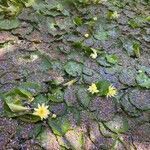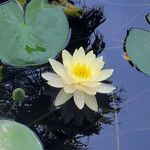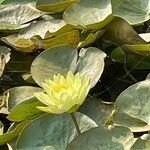Perennial; rhizomes vertical; stolons horizontal. Leaf lamina orbicular, to 26 cm wide, slightly sinuate, often with brown blotches; undersurface glabrous. Flowers standing just above the water. Sepals 4, to 9 cm long, obtuse, green outside streaked with pink. Petals to c. 30, lanceolate to oblanceolate, usually acute, yellow, outer petals often streaked pink. Stamens to c. 60; filaments membranous, flattened, to 38 mm long; anthers to 10 mm long, apiculate. Carpels 8–10; sterile stigmatic lobes 5–7 mm long. Fruit globose, to 3 cm diam. Seeds uncommon, apparently c. 5–6 mm long, ± globose, glabrous or finely hairy.
Aquatic herb. Rhizome erect, stout, bearing submerged narrowly hastate lvs; brood-bodies present, resembling tiny hands of bananas. Mature lvs suborbicular to elliptic with deep narrow basal sinus, entire to crenulate, glabrous, brown-blotched, 10-20-(25) × 10-20-(25) cm; basal lobes ± overlapping. Sepals 4, narrowly lanceolate, acute, yellow above, greenish beneath, obscurely veined, decaying after flowering, (45)-70-90 × 10-15 mm. Petals yellow, veined, c. 60 × (3)-8-10 mm. Filaments of innermost stamens 0.6-1 mm wide. Stigma flat; rays c. 8-10. Seeds 2-3 mm long.
Floating aquatic herb. Leaves with blade ± orbicular, 80-150 mm in diameter. Flowers: sepals 25-50 mm long, outer surface green, often suffused with purple, yellowish on inside; petals as long as sepals, bright yellow; Nov.-Jan.



